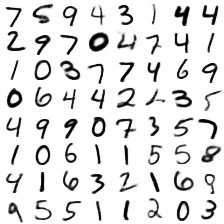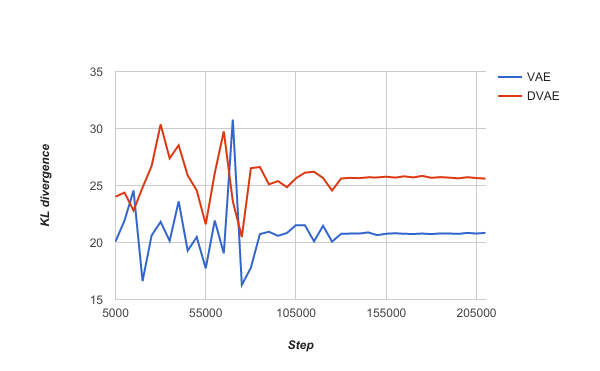The purpose of this project is to compare a different method of applying denoising criterion to a variational autoencoder model. A slightly different approach has previously been implemented as an explicit corruption of the input as would be done for a traditional denoising autoencoder (DAE), but applied it to a variational autoencoder (VAE) (Im et al., 2016 [1]). In this project the output of the generative network of the VAE is treated as a distorted input for the DAE, with the loss propogated back to the VAE, which is referred to as the denoising variational autoencoder (DVAE).
This project was created in Tensorflow (version 0.12.1) partly as a way to familiarize myself with it. Tensorflow should be the only requirement for running the underlying code.
There are two test datasets used for this project, the MNIST dataset and the CIFAR-10 dataset.
For both the VAE and the DAE the recognition model is composed of a convolutional neural network (CNN) with a batch normalization layer before each activation function. The generative model similarly uses batch normalization, but is a deconvolutional network (DN). The VAE uses a latent space of 50 samples for the MNIST dataset and 100 samples for the CIFAR-10 dataset.
The input from the dataset is feed into a VAE. The variational lower bound is optimized to minimize the KL-divergence (KLD) along with the expected reconstruction error. The output of the generative network of the VAE is then fed to a DAE which treats the generated image as a distorted input and tries to minimize the reconstruction error based on the original input.
The joint optimization of these two networks results in the loss propagating from the DAE to the VAE to help drive down the variational lower bound.
In order to determine if adding a denoising criterion improved performance, the normal VAE was compared to the DVAE. This was performed on both datasets.
For the MNIST dataset there are 60000 training images, of which 6000 were used as a hold out validation set, and there are 10000 test images.
For the CIFAR-10 dataset there are 50000 training images, of which 5000 were used as a hold out validation set, and there are 10000 test images.
Model Loss and KL-divergence
| Model | Dataset | Samples | Testing Loss | Testing KLD |
|---|---|---|---|---|
| VAE | MNIST | 1 | 74.248 | 20.900 |
| DVAE | MNIST | 1 | 71.648 | 25.728 |
| VAE | MNIST | 5 | 68.786 | 14.333 |
| DVAE | MNIST | 5 | 65.132 | 19.581 |
| VAE | CIFAR-10 | 1 | 1811.562 | 35.668 |
| DVAE | CIFAR-10 | 1 | 1790.816 | 52.144 |
| VAE | CIFAR-10 | 5 | 1787.758 | 24.735 |
| DVAE | CIFAR-10 | 5 | 1783.657 | 35.619 |
As an additional way to measure performance of the resultant models a separate CNN classification model was generated using a softmax activation and the cross entropy loss. The images generated from the VAE and DVAE were fed to the classification model to determine the classification error rate of the two autoencoder networks.
CNN Classification Error
| Dataset | Testing Error Rate |
|---|---|
| MNIST | 1.01% |
| CIFAR-10 | 22.23% |
Generated Image Classification Error
| Model | Dataset | Samples | Testing Error Rate |
|---|---|---|---|
| VAE | MNIST | 1 | 3.85% |
| DVAE | MNIST | 1 | 2.99% |
| VAE | MNIST | 5 | 2.16% |
| DVAE | MNIST | 5 | 1.66% |
| VAE | CIFAR-10 | 1 | 71.84% |
| DVAE | CIFAR-10 | 1 | 70.61% |
| VAE | CIFAR-10 | 5 | 71.76% |
| DVAE | CIFAR-10 | 5 | 70.61% |
Here are the graphs of the loss and KL divergence on the validation set over time during training of the VAE and DVAE models on the MNIST dataset (samples=1):
MNIST Loss
MNIST KL Divergence
These are example inputs and outputs from the VAE and DVAE models on the testing dataset (samples=1):
| Input | VAE Output | DVAE Output |
|---|---|---|
 |
 |
 |
Here are the graphs of the loss and KL divergence on the validation set over time during training of the VAE and DVAE models on the CIFAR-10 dataset (samples=1):
CIFAR-10 Loss
CIFAR-10 KL Divergence
These are example inputs and outputs from the VAE and DVAE models on the CIFAR-10 testing dataset (samples=1):
| Input | VAE Output | DVAE Output |
|---|---|---|
 |
 |
 |
By looking at the results it is clear that there is contention between reducing the KLD and reducing the overall loss. This is apparent in the fact that the loss for the DVAE model is lower than the loss for the VAE model, while the KLD for the DVAE model is higher than it is for the VAE model.
The reasons for this discrepancy is likely due to the unimodal nature of the Gaussian distribution used as the basis for determining the KLD. Since the distribution may only be centered around a single point the only way to make the model more accurately recreate the input is to force the KLD to increase. Rather it seems that adding additional clusters through the use of a Gaussian Mixture Model as the basis for generating the prior may allow a reduction in the model loss with while also reducing the KLD (Dilokthanakul et al., 2017 [2]).
Dilokthanakul, Nat, et al. "Deep Unsupervised Clustering with Gaussian Mixture Variational Autoencoders." arXiv preprint arXiv:1611.02648 (2016).
Im, Daniel Jiwoong, et al. "Denoising criterion for variational auto-encoding framework." arXiv preprint arXiv:1511.06406 (2015).



